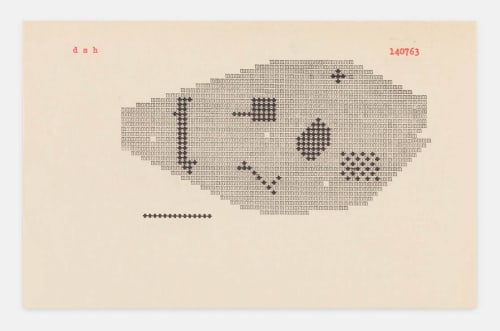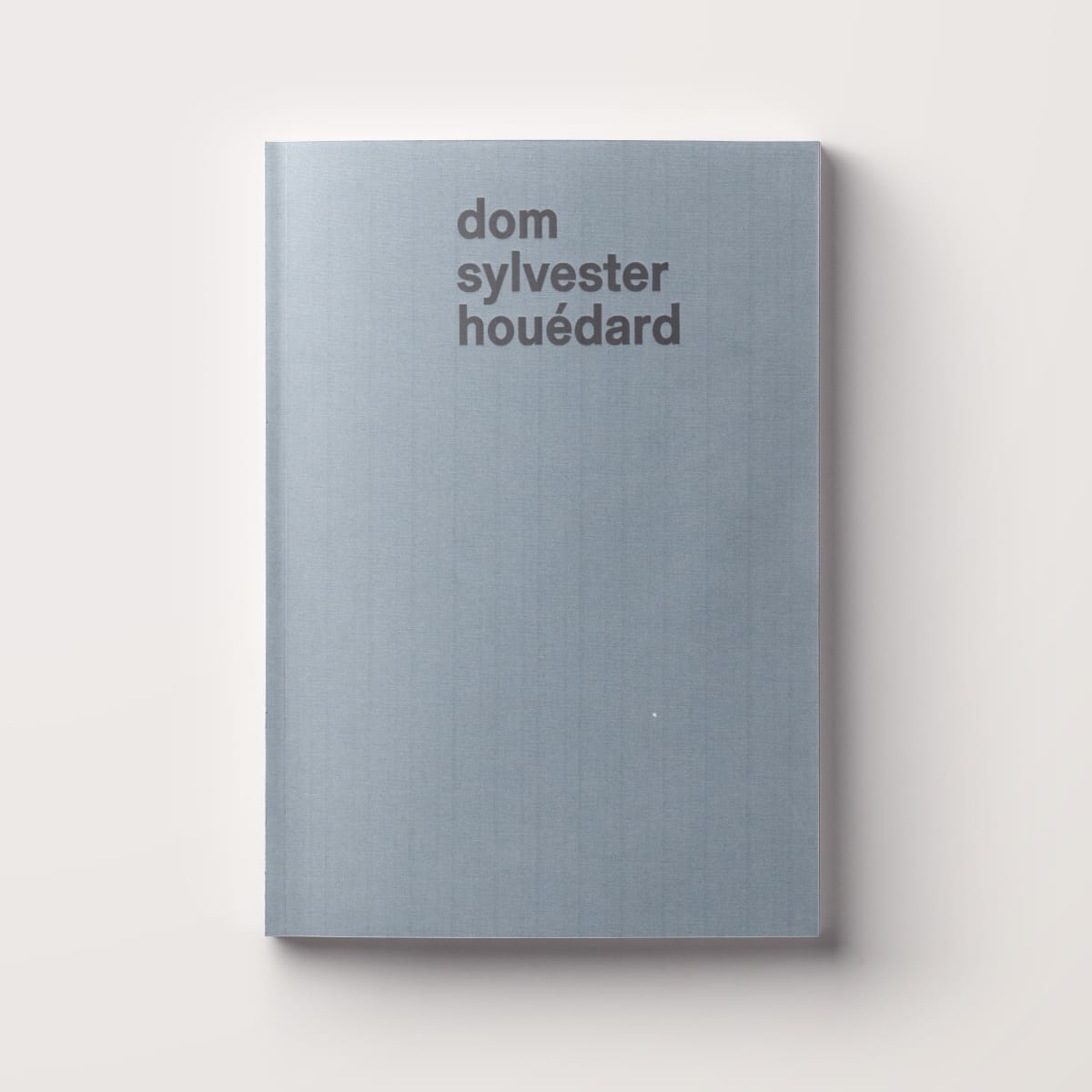Dom Sylvester HOUÉDARD: Typestracts
Richard Saltoun Gallery presents a rare solo exhibition of the British monk Dom Sylvester HOUÉDARD, a seminal counter-culture figure of 1960s London. The exhibition, curated by Andy Hunt, is the first in London in almost 50 years.
1960s America gave the world Jack Kerouac, Allen Ginsberg and a roster of other Beat poets. In Britain the Beat movement was altogether more sedate, but in typical low-key fashion, it did produce one truly outstanding counter-culture figure: Dom Sylvester Houédard, Benedictine monk, artist, poet, intellectual and theologian.
This first substantial presentation of the artist in almost five decades aims to reinstate the importance of Dom Sylvester Houédard as a key figure of the counter-cultural and transnational art movements of the 1960s and early 1970s.
-
 Installation view, Dom Sylvester Houédard: TypestractsPhoto by FXP photography, 'Lucida Sans Unicode', Verdana, Arial, Helvetica, sans-serif;">
Installation view, Dom Sylvester Houédard: TypestractsPhoto by FXP photography, 'Lucida Sans Unicode', Verdana, Arial, Helvetica, sans-serif;"> -
 Installation view, Dom Sylvester Houédard: TypestractsPhoto by FXP photography, 'Lucida Sans Unicode', Verdana, Arial, Helvetica, sans-serif;">
Installation view, Dom Sylvester Houédard: TypestractsPhoto by FXP photography, 'Lucida Sans Unicode', Verdana, Arial, Helvetica, sans-serif;"> -
 Installation view, Dom Sylvester Houédard: TypestractsPhoto by FXP photography, 'Lucida Sans Unicode', Verdana, Arial, Helvetica, sans-serif;">
Installation view, Dom Sylvester Houédard: TypestractsPhoto by FXP photography, 'Lucida Sans Unicode', Verdana, Arial, Helvetica, sans-serif;"> -
 Installation view, Dom Sylvester Houédard: TypestractsPhoto by FXP photography, 'Lucida Sans Unicode', Verdana, Arial, Helvetica, sans-serif;">
Installation view, Dom Sylvester Houédard: TypestractsPhoto by FXP photography, 'Lucida Sans Unicode', Verdana, Arial, Helvetica, sans-serif;"> -
 Installation view, Dom Sylvester Houédard: TypestractsPhoto by FXP photography, 'Lucida Sans Unicode', Verdana, Arial, Helvetica, sans-serif;">
Installation view, Dom Sylvester Houédard: TypestractsPhoto by FXP photography, 'Lucida Sans Unicode', Verdana, Arial, Helvetica, sans-serif;">
Richard Saltoun Gallery presents a rare solo exhibition of the British monk Dom Sylvester HOUÉDARD, a seminal counter-culture figure of 1960s London. The exhibition, curated by Andrew Hunt, is the first in London in almost 50 years.
1960s America gave the world Jack Kerouac, Allen Ginsberg and a roster of other Beat poets. In Britain the Beat movement was altogether more sedate, but in typical low-key fashion, it did produce one truly outstanding counter-culture figure; Dom Sylvester Houédard, Benedictine monk, artist, poet, intellectual and theologian.
Dom Sylvester Houédard (or dsh, as he was known) was a contradictory and elusive figure whose work has been assiduously collected over the years by aficionados of Concrete Poetry and typewriter art. In a rare solo exhibition, Richard Saltoun Gallery has brought together a remarkable collection of his work, curated by Andrew Hunt, that covers the key years between 1963 – 1975.
This first substantial presentation of the artist in almost five decades, aims to reinstate the importance of Dom Sylvester Houédard as a key figure of the counter-cultural and transnational art movements of the 1960s and early 1970s.
Widely recognised during his lifetime as one of the leading theorists and outstanding practitioners of concrete poetry, dsh's work, both as an artist and theologian, combined with his eccentricity, erudition and faith has made it impossible to place him in any single movement or clique.
In the early '60s, dsh, was writing semi-confessional 'neo-beat' free verse. He was inspired by the Brazilian artist E.M de Melo e Castro, who described concrete poetry as 'an experiment in ideogrammatic or diagrammatic writing and poetic creation'. Under this influence, Houédard started creating poems in which 'words unsay themselves in a performative strategy of dis-ontology'. He quickly opened up the parameters of Concrete Poetry to include mail art, kinetic art, 'part-art' and performance art.
Towards the mid '70s such was his fame that his presence became problematic for his monastery, not least because his connection with the prevailing revolutionary moment meant that he dealt also with politically and sexually explicit subject matter. Gradually, under pressure from the monastery, he turned to matters of theology and ceased his artistic practices.
dsh exhibited regularly in the '60s; at the Signals Gallery, Lisson Gallery and the ICA and was championed by renowned art historian Guy Brett. The V&A museum held a retrospective of his work (1971) and he exhibited internationally throughout the 70s, becoming a key figure in the international Concrete Poetry movement. Since the 1970s, the scarcity of his work (his estate was bequeathed to a UK library) and his reputation as a theologian and aesthete, has turned this avant-garde artist into a semi-mythical figure.
The exhibition at Richard Saltoun Gallery, showcases a comprehensive collection of typestracts that Houédard produced between 1963 and 1975 and aims to show how this complex man and artist deserves to be fully acknowledged as one of the leading influencers and visionaries of the British1960s cultural and artistic revolution.
The exhibition will present an evening of performances inspired by a selection of dsh's Onomasticons and Typestracts. Curated by Nicola Simpson, researcher at Norwich University of the Arts. A monograph on Dom Sylvester Houédard, published for the occasion by Ridinghouse, will be available.
Andrew Hunt is currently a Research Fellow in the Faculty of Art, Design & Architecture at Kingston University and Co-Director of Reading International. Recent independent projects include As You Change So Do I, a series of public art commissions for Luton, UK (2016 to 2019), and Concerning Concrete Poetry, Badischer Kunstverein, Karlsruhe (2016). From 2008 to 2014 he was Director of Focal Point Gallery in Southend-on-Sea, and in 2012 he was a member of the Turner Prize jury.







